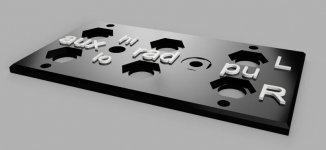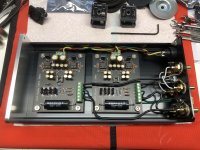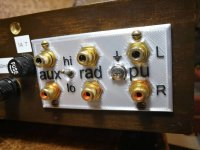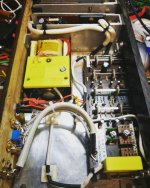I'm revamping an old Sinclair Project Sixty integrated amp, which used to have DIN inputs but I'm fitting RCA inputs.
One thing I overlooked was a grounding lug for the phono input.
The case is non metal and I want to run the ground lug internally back to the preamplifier board.
What I'm trying to figure out is a good design for the ground lug itself. Commercial designs I've seen vary but seem to centre around an M3 screw into a terminal or threaded into the chassis.
I was thinking since I'm using a 3d printed input panel, I would create a slot, feed a ring terminal through from the inside, bend it 90 degrees so it sits flat against a shallow inset in the rear panel, and add a recessed/captive M3 nut on the inside. Then put an M3 thumbscrew with a corrugated lock washer, some of the thread removed nearest the end and a nut loctited on the very end once it's through so it cannot be unscrewed all the way.
Does this seem like a good way to do it, or is there another setup which has worked well for others? A binding post might work but I've had trouble finding nice small ones.
One thing I overlooked was a grounding lug for the phono input.
The case is non metal and I want to run the ground lug internally back to the preamplifier board.
What I'm trying to figure out is a good design for the ground lug itself. Commercial designs I've seen vary but seem to centre around an M3 screw into a terminal or threaded into the chassis.
I was thinking since I'm using a 3d printed input panel, I would create a slot, feed a ring terminal through from the inside, bend it 90 degrees so it sits flat against a shallow inset in the rear panel, and add a recessed/captive M3 nut on the inside. Then put an M3 thumbscrew with a corrugated lock washer, some of the thread removed nearest the end and a nut loctited on the very end once it's through so it cannot be unscrewed all the way.
Does this seem like a good way to do it, or is there another setup which has worked well for others? A binding post might work but I've had trouble finding nice small ones.
@rayma it looks good, but I'm not sure how that binding post accepts a U lug as is found on most turntable cords?
Had a little rummage and found some NOS screw type speaker terminals, they came as 4 mounted in a sheet of phenolic. I think this will fit the bill.
Not as convenient as a thumb screw but I could swap it if I wanted to, it's an M4 thread.
Still interested to see what other DIY solutions people have come up with for this ...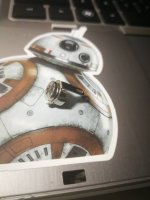
Not as convenient as a thumb screw but I could swap it if I wanted to, it's an M4 thread.
Still interested to see what other DIY solutions people have come up with for this ...

I used brass lamp and various other bits I found at my local hardware store (some stores are definitely better than others).
I used a combination of stainless screw, lock washer and nut to clamp it to the panel. Internally the ground is held under the screw head with a ring terminal. Externally there is an extra stainless washer and brass thumb screw.
Not sure if this fulfills any special requirements you have with a non conductive back panel, but I’ve done the same thing with two different phono amps and the first case was built with a combination of wood and aluminum. I covered the internal surfaces of the wood with a conductive copper foil shield.
Here’s a few better pics of the VSPS I used it on.
I used a combination of stainless screw, lock washer and nut to clamp it to the panel. Internally the ground is held under the screw head with a ring terminal. Externally there is an extra stainless washer and brass thumb screw.
Not sure if this fulfills any special requirements you have with a non conductive back panel, but I’ve done the same thing with two different phono amps and the first case was built with a combination of wood and aluminum. I covered the internal surfaces of the wood with a conductive copper foil shield.
Here’s a few better pics of the VSPS I used it on.
Attachments
That's a lovely brass knob!
Yes, the amp has a sheet of what is presumably aluminium in the base, connected to Ground (and safety ground). Which seems to be sufficient, at least with this very simple amplifier, at keeping RF interference at bay.
Funny thing is I've found is, with my tt at least, there is less (basically no) hum with the ground lead disconnected. I found the biggest difference then comes down to routing of the interconnect.
Yes, the amp has a sheet of what is presumably aluminium in the base, connected to Ground (and safety ground). Which seems to be sufficient, at least with this very simple amplifier, at keeping RF interference at bay.
Funny thing is I've found is, with my tt at least, there is less (basically no) hum with the ground lead disconnected. I found the biggest difference then comes down to routing of the interconnect.
It's a vintage piece, and just for a second system, more about the aesthetic than high performance. I don't want to alter it too much. If it really is a big problem I'll add some shielding.A phone pre-amp in a non-metal enclosure, is an interference problem just waiting to happen.
@rayma it looks good, but I'm not sure how that binding post accepts a U lug
as is found on most turntable cords?
Replace the lug, a stripped tinned wire is fine.
A phone pre-amp in a non-metal enclosure, is an interference problem just waiting to happen.
It won't wait, it will happen immediately.
- Home
- Source & Line
- Analog Line Level
- DIY Ground lug for Phono input, non metal case
